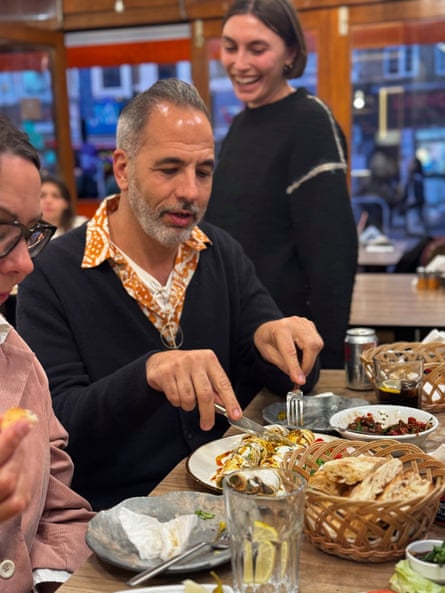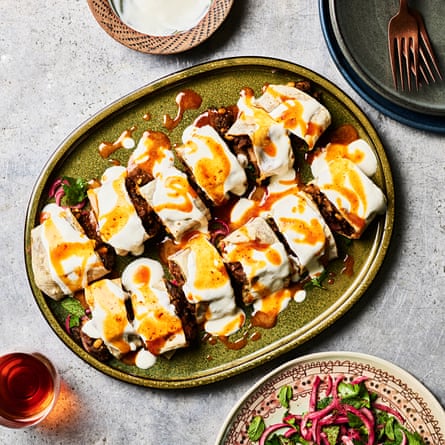What does it feel like to eat out in London these days? And what do people want? I’ve been asking myself these questions since closing our restaurant Rovi for renovations this summer, taking the opportunity to rethink some of the things we do.
It has become clear to me that the restaurant world I’ve known for decades is radically changing through a combination of factors: people’s working patterns, health obsessions, the falling out of love with alcohol and the falling in love with pastries and bread, but, predominantly, the affordability of it all.
The numbers are genuinely frightening: in my restaurants, utility costs are up more than 50% since 2019; chocolate prices have doubled; olive oil is up 121%; even spring onions are up 55% – spring onions! Meanwhile, customers are feeling the squeeze just as hard: 52% of UK consumers have cut non-essential spending, with 72% of those naming “eating out” as one of their cuts. With London renters now spending an average of 41.6% of their income on rent alone, something has to give.
My first panicky instinct was: we’re all fighting to survive in an industry that’s eating itself. But step outside and you’ll notice something unexpected. Everyone’s facing the same brutal economics, but the responses are all over the place. Some solutions are radical, some simple, some totally bonkers – and some are really working.
Rotisserie chicken is suddenly everywhere: Norbert’s in East Dulwich; Cocotte expanding beyond its Notting Hill site; Chick’n’Sours pivoting toward rotisserie; newcomers such as Chicken Shop. It hits every pressure point: affordable protein, simple prep, fast turnover. Half a chicken and sides for £15 feels like good value when everything else has become expensive and fiddly.
The Yellow Bittern went in the opposite direction. Instead of making things easier and more affordable, they made them harder and more expensive. Eighteen seats behind Kings Cross station, doorbell entry, a portrait of Lenin watching you eat a £50 lunch, closed for dinner, no cards, no website. When customers didn’t spend enough one day, the chef posted on Instagram asking them to “justify their presence”. Sounds mad, but everyone’s talking about it.
The grocery shop-restaurant hybrid is another solution that’s spreading fast, particularly at the higher end. Places like Corner Shop 180, Honey & Spice and Leila’s Shop make the profit margins more manageable by hedging their bets and offering a new kind of dining alongside the shopping experience. It seems obvious when you say it like that, but it’s surprisingly hard to actually do.

Reading Jonathan Nunn’s book London Feeds Itself made me realise what I’m seeing in restaurants is part of something much larger. Nunn writes about how London feeds itself “in so many unusual ways – in its warehouses, mosques, community centres, and even in baths – spaces where monetary transaction is peripheral or even completely absent”. This city has always nourished itself creatively, often driven by waves of immigrants who arrive with skills, recipes and a bloody-minded determination to make something work.
I go to Turkish restaurants for some of the best meals in the city. My test kitchen has become obsessed with tantuni (see recipe, below)– we’ll disappear for lunch and come back debating the lavash flatbread, the spice of the butter, whether there was enough yoghurt sauce. Right now, Neco Tantuni in Enfield and Mersin Tantuni in Dalston are winning.
The story of Mangal in Dalston shows how this evolution works. Ali Dirik moved from Istanbul in 1987 and opened Mangal I, a real charcoal-cooking restaurant not seen here before. Then he opened Mangal II in 1994, which offers so much of what London wants: small plates, good wine, sharing everything. His son Ferhat runs it now, and has kept his father’s original Adana kebabs while adding dishes like grilled ox heart with sumac and wild garlic. It’s Turkish, but also completely London: that willingness to evolve while staying true to what you are.
This pattern is repeating across London. In New Malden, Korean families have built something incredible – a whole strip of restaurants serving pajeon and bulgogi to their community. Now, places such as Cah Chi are packed with Londoners who’ve figured out that this is some of the best food in the city. In Elephant and Castle, Filipino families opened canteens in community centres before graduating to restaurants like Sarap Filipino Bistro in Soho (since closed but looking for a new home), bringing dishes such as sisig and adobo to adventurous London palates.
Some of the most innovative responses combine food with community building. Migrateful, founded in 2017, trains refugees and migrants to become cookery teachers, running classes across London where participants learn to cook dishes from Syria, Afghanistan, Eritrea and beyond, while hearing the stories behind the recipes. It’s not so much a restaurant – though the food is extraordinary – as about creating opportunities and cultural exchange simultaneously. Since launching, it has supported more than 200 chefs and served more than 15,000 students.
During Covid, we proved how adaptable our industry could be. We became grocers, takeaway specialists and community kitchens overnight. Even restaurants you would normally book weeks ahead – Gymkhana, Lyle’s, Hoppers – started offering meal kits. That same ingenuity has evolved – people building businesses from the ground up with adaptability built in, rather than having to retrofit it during a crisis.
The restaurants thriving now aren’t the ones trying to recreate the old model with higher prices. They’re the ones who have figured out new models entirely: the chicken specialists, the doorbell restaurants, the grocery-restaurant hybrids, the community teachers, the cultural translators. They’re not waiting for things to get easier; they’re making excellence work within the constraints they have.
I think I’ve been looking at this all wrong. The frantic booking apps, the eye-watering costs, the constant pressure to innovate … These aren’t just signs of an industry in crisis. They are signs of an industry that’s more alive and creative than it has ever been.
The spring onions will cost what they cost. But people who care about feeding others well keep finding new ways to do it. That’s what resilience looks like.
The question isn’t whether London’s restaurant scene will survive – it’s what brilliant, unexpected form it will take next.
Pumpkin muhammara with peppers and date molasses (pictured above)
This is based on the muhammara we serve at Rovi. The traditional Syrian version is made of roasted red peppers, walnuts and pomegranate molasses, but this one swaps half the peppers for pumpkin, which makes it creamier and less sharp. Look for delica pumpkin if you can find it, or any firm-fleshed, deeply orange squash such as onion squash or crown prince. We use pilpelchuma (a fermented pepper paste) for the topping, but rose harissa works just as well. You can roast the pumpkin and peppers the day before, which makes this ideal for parties when you need something mostly hands-off.
Prep 30 min
Cook 50 min
Serves 6-8
1 small delica pumpkin (900g), halved and deseeded
6 red peppers (800g)
60ml olive oil
1 garlic clove, peeled and crushed
2½ tbsp lemon juice
80g walnuts, lightly toasted and roughly chopped
2 tbsp date molasses, plus 1½ tsp extra
Fine sea salt and black pepper
50g pilpelchuma, or rose harissa
1 tsp cumin seeds, roughly crushed
½ tsp aleppo chilli
To serve
Seeded crackers or pitta bread
Heat the oven to 200C (180C fan)/390F/gas 6. Place the pumpkin halves cut side down on a lined oven tray, arrange the red peppers alongside and drizzle both with a tablespoon of oil. Roast for 25-30 minutes, by which time the peppers’ skin should be blistered and blackened in places. Lift them off the tray, put them in a bowl and cover with a plate to steam. Continue to roast the pumpkin for another 20-25 minutes, until softened, then leave to cool completely.
after newsletter promotion
Peel the peppers and discard the skins, stems and any liquid. Using a spoon, scoop out the flesh of the pumpkin halves, and discard the skin and any hard caramelised bits. You should end up with about 400g roast pumpkin flesh.
To make the muhammara, put the pumpkin and 200g of the peppers in a food processor. Add the garlic, 2 tablespoons of lemon juice, 50g of the walnuts, 2 tablespoons of the date molasses, 1¼ teaspoons of salt and a good grind of pepper. Pour in 170ml water and blitz until completely smooth and silky.
Chop the remaining pepper flesh into 1cm pieces and put these in a bowl with the remaining 3 tablespoons of oil, ½ tablespoon of lemon juice, the extra 1½ teaspoons of date molasses, the pilpelchuma (or harissa) and ¼ teaspoon of salt. Mix well.
To assemble, spread the muhammara on a platter, followed by the chopped pepper mix and all its oil. Scatter over the remaining walnuts, cumin seeds and aleppo chilli, then serve with plenty of seeded crackers or pitta.
Lamb and aubergine tantuni with garlic yoghurt and burnt butter

There’s a spot in east London called Mersin Tantuni that my team and I love – small, always busy, with a griddle visible from the street. Tantuni is Turkish street food from Mersin on the southern coast: finely chopped lamb or beef cooked on a griddle until crisp at the edges, mixed with tomatoes and peppers, then wrapped in the thinnest possible lavash bread and rolled like a cigar. It’s cut into fat rounds, doused in burnt butter and arrives at your table still sizzling. This version adds aubergine, which soaks up the lamb fat and spices, going soft and almost creamy. The burnt butter – with cumin and aleppo chilli – is what makes it feel authentic. Lavash is available in Middle Eastern supermarkets; you want the thinnest you can find, warmed briefly over the hot lamb so it softens and picks up the juices without going soggy.
Prep 30 min
Cook 40 min
Serves 2 as a main or 4 as a snack
For the lamb
1 tbsp olive oil
300g lamb shoulder, cut into 1cm pieces
1 large or 2 small aubergine (300g), cut into 1cm pieces
Fine sea salt and black pepper
1 small garlic clove, peeled and crushed
¼ tsp smoked paprika
1 tsp cumin seeds, lightly ground in a mortar
1½ tbsp pine nuts
For the garlic yoghurt
100g Greek yoghurt
1 small garlic clove, peeled and crushed
1 tsp lemon juice
For the sumac onions
1 red onion (125g), peeled and thinly sliced
1 tbsp lemon juice
¾ tsp sumac
10g picked parsley
10g picked mint, roughly torn
For the burnt butter
40g unsalted butter
¼ tsp cumin seeds, lightly crushed
1 tsp aleppo chilli
⅛ tsp smoked paprika
To serve
2 lavash bread or 4 of the thinnest flatbreads you can get
Put the oil in a large saute pan on a medium- high heat and, once hot, add the lamb, aubergine, ½ teaspoon of salt and a good grind of pepper. Cook, stirring frequently, for 15 minutes, until golden. Stir in the garlic, paprika and cumin, cook for another 30 seconds, then pour in 200ml water, stir well and cover with a lid. Turn down the heat to medium, and cook for another 20 minutes, until the water has evaporated and the lamb is tender. Stir in the pine nuts and cook for another 3 minutes.
Meanwhile, put all the yoghurt ingredients in a bowl with a tablespoon of water and a good pinch of salt. Mix well and set aside at room temperature.
For the sumac onions, put the onions, lemon juice, sumac and ⅛ teaspoon of salt in a bowl. Mix gently with a spoon and set aside to cure until bright pink. Add the parsley and mint just before serving.
Put the butter in a small saucepan on a medium heat and cook for 3-4 minutes, until the milk solids have browned at the bottom of the pan and the butter smells nutty. Add the cumin, aleppo chilli and paprika, cook for 30 seconds more, then take off the heat.
To assemble, briefly dunk the lavash over the hot lamb to soften and soak up some of the fat and juices. Divide the lamb between the two lavash, arrange half the sumac onions on top (sav the rest for serving) and roll like a cigar with the seam side down.
Using a serrated knife, cut the tantuni into 4-5cm pieces and arrange these seam side down on a serving platter. Spoon over the yoghurt and pour over the hot butter. Serve with the remaining sumac onions on the side.

 1 month ago
24
1 month ago
24

















































